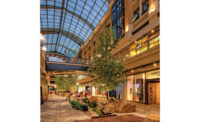

With all the heavy lifting done, three waterfalls cascading and the fish spawning, no one would suspect how much strenuous exercise it took to design, engineer and construct a 1,225-ft-long replica of Salt Lake City's City Creek. But that's because the shallow creek looks so real that no one can tell it is built on structure in a high seismic zone.
The emotional centerpiece of the eponymous urban renewal project, developed by the Church of Jesus Christ of Latter-Day Saints, needed a superdeck that could support 400 psf in places, thanks to loads imposed by 660 boulders with a collective weight of 420 tons.
The church, which traces its roots to the real City Creek that nourished its 18th century settlers, wanted to bring back the downtown stretch, which had been culverted or buried. "When we started the project, we didn't know what we were getting ourselves into," says Rene Bihan, managing principal in the San Francisco office of landscape architect SWA Group, which designed the replica. "The first time we presented our ideas, we were thinking in a fairly conventional way, but Bishop Burton kept saying, 'No, we want the real creek.' So we went hiking."
The replica follows the dimensions of the real City Creek. All the rock, called Mountain Valley Sandstone, is from Brown Canyon, Utah. Mountain Valley Stone supplied it and Delta Stone Products Inc., both in Heber, Utah, fabricated it. "We did not want to quarry the real creek. It would defeat the purpose of preserving it," says Bihan.
The heaviest boulders create an 18-ft-tall
waterfall in an area of the project that was so complicated, it was dubbed the Bermuda Triangle. Those boulders weigh 12.5 tons each and measure 15 x 10 x 8 ft. Between the location and their weight, the only practical way for crews to install them was to use a tower crane on rails. The crane would pick up each boulder from a truck in a nearby alley, set it on the superdeck, "walk" into position and pick up the boulder again to place it.
"That's something you don't see every day," says Brent Rowley, project manager for the local Jacobsen Construction Co. Inc., the construction manager-general contractor for the creek replica.
Another thing not seen every day is a 40-ft-wide, 22-ft-tall and 80-ft-long concrete mock-up, built at stone fabricator Delta Stone Products some 60 miles from the 23-acre City Creek development. Crews used the mock-up to preassemble the boulders for the 18-ft-tall waterfall. The mock-up was shot by survey crews so the "real" concrete base could be properly constructed at the site.
The replica, from 1 to 28 ft wide and 4 to 18 in. deep, "flows" in the center of a 3- to 5-ft-deep depression in the superdeck. The creek is actually a series of pools filled with recycling water.
The creek, which contains 112,000 gallons of water, was finished in October. There are 200 rainbow and cutthroat trout in a 200-ft-long stretch and a 1,500-sq-ft pond.
"They are thriving," says Bihan.



Post a comment to this article
Report Abusive Comment